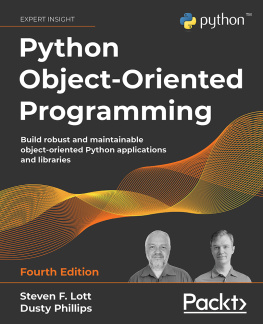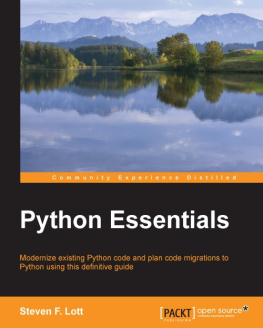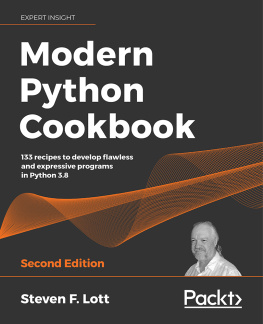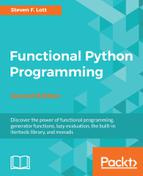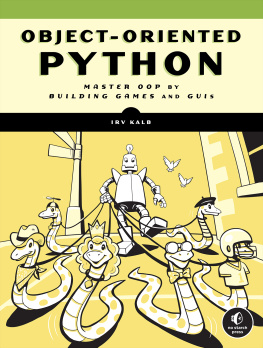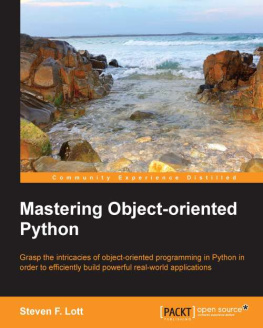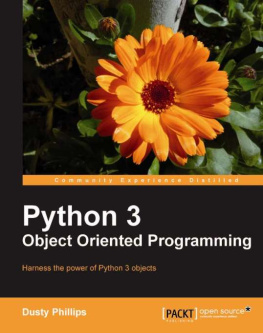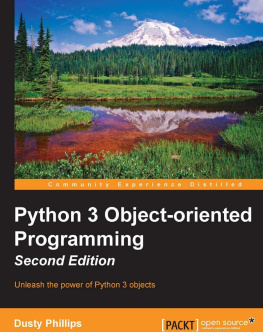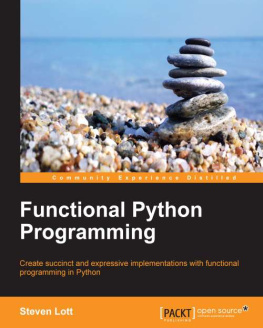Steven F. Lott - Python Object-Oriented Programming
Here you can read online Steven F. Lott - Python Object-Oriented Programming full text of the book (entire story) in english for free. Download pdf and epub, get meaning, cover and reviews about this ebook. year: 2021, publisher: Packt, genre: Home and family. Description of the work, (preface) as well as reviews are available. Best literature library LitArk.com created for fans of good reading and offers a wide selection of genres:
Romance novel
Science fiction
Adventure
Detective
Science
History
Home and family
Prose
Art
Politics
Computer
Non-fiction
Religion
Business
Children
Humor
Choose a favorite category and find really read worthwhile books. Enjoy immersion in the world of imagination, feel the emotions of the characters or learn something new for yourself, make an fascinating discovery.
- Book:Python Object-Oriented Programming
- Author:
- Publisher:Packt
- Genre:
- Year:2021
- Rating:4 / 5
- Favourites:Add to favourites
- Your mark:
- 80
- 1
- 2
- 3
- 4
- 5
Python Object-Oriented Programming: summary, description and annotation
We offer to read an annotation, description, summary or preface (depends on what the author of the book "Python Object-Oriented Programming" wrote himself). If you haven't found the necessary information about the book — write in the comments, we will try to find it.
Python Object-Oriented Programming — read online for free the complete book (whole text) full work
Below is the text of the book, divided by pages. System saving the place of the last page read, allows you to conveniently read the book "Python Object-Oriented Programming" online for free, without having to search again every time where you left off. Put a bookmark, and you can go to the page where you finished reading at any time.
Font size:
Interval:
Bookmark:

Python Object-Oriented Programming
Fourth Edition
Build robust and maintainable object-oriented Python applications and libraries
Steven F. Lott
Dusty Phillips

BIRMINGHAMMUMBAI
"Python" and the Python Logo are trademarks of the Python Software Foundation.
Python Object-Oriented Programming
Fourth Edition
Copyright 2021 Packt Publishing
All rights reserved. No part of this book may be reproduced, stored in a retrieval system, or transmitted in any form or by any means, without the prior written permission of the publisher, except in the case of brief quotations embedded in critical articles or reviews.
Every effort has been made in the preparation of this book to ensure the accuracy of the information presented. However, the information contained in this book is sold without warranty, either express or implied. Neither the authors, nor Packt Publishing or its dealers and distributors, will be held liable for any damages caused or alleged to have been caused directly or indirectly by this book.
Packt Publishing has endeavored to provide trademark information about all of the companies and products mentioned in this book by the appropriate use of capitals. However, Packt Publishing cannot guarantee the accuracy of this information.
Producer: Dr. Shailesh Jain
Acquisition Editor Peer Reviews: Saby D'silva
Project Editor: Parvathy Nair
Content Development Editor: Lucy Wan
Copy Editor: Safis Editor
Technical Editor: Aditya Sawant
Proofreader: Safis Editor
Indexer: Tejal Daruwale Soni
Presentation Designer: Pranit Padwal
First published: July 2010
Second edition: August 2015
Third edition: October 2018
Fourth edition: June 2021
Production reference: 2281221
Published by Packt Publishing Ltd.
Livery Place
35 Livery Street
Birmingham
B3 2PB, UK.
ISBN 978-1-80107-726-2
www.packt.com
Steven Lott has been programming since computers were large, expensive, and rare. Working for decades in high tech has given him exposure to a lot of ideas and techniquessome bad, but most are useful and helpful to others.
Steven has been working with Python since the '90s, building a variety of tools and applications. He's written a number of titles for Packt Publishing, including Mastering Object-Oriented, Modern Python Cookbook, and Functional Python Programming.
He's a technomad, and lives on a boat that's usually located on the east coast of the US. He tries to live by the words "Don't come home until you have a story."
Dusty Phillips is a Canadian author and software developer. His storied career has included roles with the world's biggest government, the world's biggest social network, a two person startup, and everything in between. In addition to Python Object-Oriented Programming, Dusty wrote Creating Apps In Kivy (O'Reilly) and is now focused on writing fiction.
Thank you to Steven Lott, for finishing what I started, to all my readers for appreciating what I write, and to my wife, Jen Phillips, for everything else.
Bernt Gbor, originally from Transylvania, works as a senior software engineer at Bloomberg in London, UK. During his day job, he primarily focuses on improving the quality of the data ingestion pipeline at Bloomberg with predominant use of the Python programming language and paradigms. He's been working with Python for over ten years and is a major open-source contributor in this domain, with a particular focus on the packaging area. He's also the author and maintainer of high-profile projects such as virtualenv, build, andtox. For more information, see https://bernat.tech/about .
I would like to express my very great appreciation to Lisa, my fiance, for her invaluable support on a daily basis. Love you!
The Python programming language is extremely popular and used for a variety of applications. The Python language is designed to make it relatively easy to create small programs. To create more sophisticated software, we need to acquire a number of important programming and software design skills.
This book describes the object-oriented approach to creating programs in Python. It introduces the terminology of object-oriented programming, demonstrating software design and Python programming through step-by-step examples. It describes how to make use of inheritance and composition to build software from individual elements. It shows how to use Python's built-in exceptions and data structures, as well as elements of the Python standard library. A number of common design patterns are described with detailed examples.
This book covers how to write automated tests to confirm that our software works. It also shows how to use the various concurrency libraries available as part of Python; this lets us write software that can make use of multiple cores and multiple processors in a modern computer. An extended case study covers a simple machine learning example, showing a number of alternative solutions to a moderately complicated problem.
This book targets people who are new to object-oriented programming in Python. It assumes basic Python skills. For readers with a background in another object-oriented programming language, this book will expose many distinctive features of Python's approach.
Because of Python's use for data science and data analytics, this book touches on the related math and statistics concepts. Some knowledge in these areas can help to make the applications of the concepts more concrete.
This book is divided into four overall sections. The first six chapters provide the core principles and concepts of object-oriented programming and how these are implemented in Python. The next three chapters take a close look at Python built-in features through the lens of object-oriented programming. Chapters 10, 11, and 12 look at a number of common design patterns and how these can be handled in Python. The final section covers two additional topics: testing and concurrency.
Chapter 1, Object-Oriented Design, introduces the core concepts underlying object-oriented design. This provides a road map through the ideas of state and behavior, attributes and methods, and how objects are grouped into classes. This chapter also looks an encapsulation, inheritance, and composition. The case study for this chapter introduces the machine learning problem, which is an implementation of a k-nearest neighbors (k-NN) classifier.
Chapter 2, Objects in Python, shows how class definitions work in Python. This will include the type annotations, called type hints, class definitions, modules, and packages. We'll talk about practical considerations for class definition and encapsulation. The case study will begin to implement some of the classes for the k-NN classifier.
Chapter 3,
Font size:
Interval:
Bookmark:
Similar books «Python Object-Oriented Programming»
Look at similar books to Python Object-Oriented Programming. We have selected literature similar in name and meaning in the hope of providing readers with more options to find new, interesting, not yet read works.
Discussion, reviews of the book Python Object-Oriented Programming and just readers' own opinions. Leave your comments, write what you think about the work, its meaning or the main characters. Specify what exactly you liked and what you didn't like, and why you think so.

